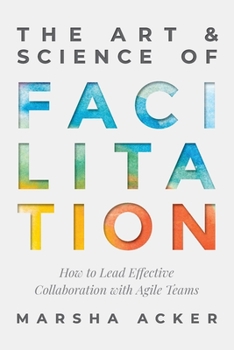Marsha Acker has built her business, TeamCatapult, on the art of intentional communication. It’s also the premise of her workbook, Build Your Model for Leading Change and the key to her book The Art and Science of Facilitation, which provides guidance on how to lead effective collaboration within teams. Through both books, Marsha holds that when we can be more intentional about how we invite, cultivate, and participate in conversations, we can navigate any challenge or change.
“If we focus on how we engage with others in conversation, we can be more effective,” Marsha says. “When we’re ineffective in our conversations, that’s when things go off the rails.”
We asked Marsha for some strategies to help our teams and clients stay on track.
What is your approach to creating intentional conversations?

My approach is based on David Kantor‘s research from the ’70s around a theory called Structural Dynamics. When we’re in what David calls “low stakes,” we’re often at our best, we’re able to let things flow. But as stakes rise, our behavior changes, and we don’t show up as our best selves, which negatively impacts those around us. “I feel like I’m on the back of my heels,” is what I say when I’m not at my best.
Part of this work is noticing when the stakes rise and asking what might be happening for you at that moment.
For instance, you might be feeling uncomfortable speaking up to people. We all have different behaviors when we’re feeling uncomfortable, some get silent, others get loud and boisterous. Many want to fix the other person, thinking things will improve once they change. All of these behaviors begin to raise the stakes. Dealing with change, especially, can make the stakes rise for people.
How does your workbook help to navigate change?
Build Your Model for Leading Change asks four key questions to guide leaders and teams through making sense of change.
First, it helps identify where we are trying to bring about change—whether in an organization, environment, or product.
Next, it helps facilitate the conversation around change.
When do we need these skills the most?
Usually it’s when things aren’t going well. That’s often when I meet with teams and individuals—when something isn’t working as they’d like it to.
We go to therapy, get coaching, or search for books to make sense of what’s happening and to find relief.
A common red flag is when you feel like you need to re-align with a team member on roles and responsibilities. This usually means there’s been a breakdown in conversation. So now you need to have the conversation you’re trying to avoid.
Can you give an example of how you work?
My company, TeamCatapult, helps leaders learn strategies to lower the stakes. In this example, we worked with two senior leaders in an organization facing a high-stakes crisis. While they both cared greatly about the organization, and the people in it, when it came down to day-to-day conversation, they kept talking past one another. One focused on quality, the other on action, leading to constant high-stakes interactions that were permeating throughout the organization.

First, I seek to understand each person’s point of view—the “moral story” which is loaded with judgments. This serves as a doorway to a different story. I encourage them to let it all out initially. Then I reflect their stories back to them and gave them a shared language—thanks to David Kantor’s meta language.
When we turn the moral story into a structural one, it helps people move from judgment to constructive conversations.
The quality-focused person was in what David calls “Open Meaning,” wanting to explore the options, while the action-focused person was in “Closed Power,” wanting to make a decision and have it followed because the focus was on action. We need both, but getting stuck in one can be problematic. These leaders learned to appreciate each other’s contributions, lowering their stakes and thereby improving communication.
Can you explain more about Closed Power?
Closed Power is how you get a paycheck every week. It’s why, when someone says they’re going to do something, they follow through and take action. So we need it, but the software community as a whole has moved away from Closed Power or as some would view, the command-and-control approach. Sometimes, I think we swung the pendulum a little too far toward collaboration.
I often talk with teams about the importance of Closed Power, emphasizing that while it has its place, we need to be careful not to get stuck in it.
Personally, I know I have a reaction when someone brings Closed Power. One way I lower my stakes is by reminding myself that they’re filling a gap that I, or our greater system, may be creating. I try to become more curious, and recognize the importance in understanding why I have a particular reaction. Can I see through that to find the important thing the other person is bringing?
What are some tricks for dealing with heated conversations?
We can reach a point where I’m no longer listening to you. I’m just continuing to say the same things and I say them louder because clearly, you didn’t hear me.
In these situations, when stakes rise, I ask people to stop talking and write things down for five minutes, anything they want to say. Maybe I’ll ask them a specific question like “What’s raising the stakes for you right now?” Afterward, I ask them if they want to share what they wrote. This strategy usually takes the heat off and helps foster understanding and empathy.
If you find you’re not listening and just repeating yourself, locate the assumption you’re making and ask if it’s correct. This might sound like, “I think you don’t like what I’m producing and are judging it. Is that true?”
What’s your explanation for why we get triggered?
David Kantor’s research in Structural Dynamics explains that high-stakes involve a context, a story, and a trigger. Context is the setting, like senior leaders under pressure. This is the ring of the campfire. Stories are our personal fears and past experiences. These are the wood. The trigger, or match, is when someone steps on a value we care about or brings up a structure that reminds us of those stories.
This involuntary reaction requires us to have strategies to stay in command of ourselves. At TeamCatapult, we use language such as “low stakes” and “high stakes” all the time in our conversations. As we often say, “See it, say it, and stay with it.”
For some teams, naming the rising stakes in a conversation is a foreign concept. That’s where we start.
Years ago, I believed that learning all this would prevent the stakes from rising. But knowing it doesn’t save you from being caught in it. The key is to practice in real-time. The goal is to have people with whom you’ve built trust to be able to say, “The stakes are rising for me; I need us to slow down or walk away.” It’s challenging to navigate high-stakes conversations in real time, but practice is what builds the skill.
What if it’s time to walk away for good?
When an organization constantly values effectiveness and productivity and undervalues relationships, it can create high-stakes behaviors that leave a lasting imprint on a person. If stuff gets shoved under the rug too long, the practice to uncover those “stuffed stakes” can threaten relationships and partnerships, causing teams or individuals to reach the end of their time together. However, I hold a belief that we can say goodbye in positive and productive ways. We can say, “I think my time here has come to an end and I want to separate.” We don’t need to flip the table, burn a bridge, make you wrong, or leave with a backpack full of gripes, right?
When we can create cultures and structures that help people feel heard and understood, that lowers the stakes for all of us, AND it helps reduce the “build-up under the rug.”
Let’s go back to our two leaders. What happens after they start understanding themselves and each other better?
Through practice in real time, they began to get their high-stakes behavior under control and started expanding the language around Structural Dynamics with their team. However, as often happens, another high-stakes moment comes along that brings them back to old patterns and residual issues from past interactions.
It’s when the pattern reoccurred that these particular individuals decided to make some commitments to each other about how they wanted to work together going forward.
No longer were they going to step over things. They carved out time in their schedules to address them every week, even if it was just for a few minutes to check in and ask, “What are we walking over or stepping past?” Addressing things as they happen is much easier than letting them build up.
You make it sound so simple and easy.
The concepts are simple, but the practice is far from easy!
However, I believe communicative competence is a skill we can all build and master.
Learn more
- Contact Marsha Acker: TeamCatapult
- Try Marsha’s workbook: Build Your Model for Leading Change
- Get Marsha’s book: The Art and Science of Facilitation
- Listen to Marsha’s podcast: Defining Moments of Leadership








